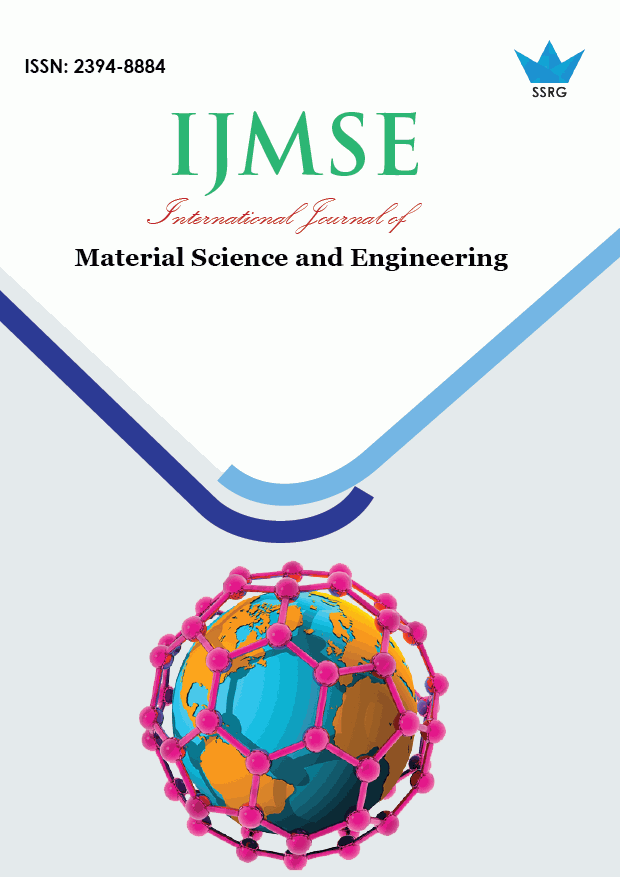Meta-analysis on the Retting of Plant Fibres

| International Journal of Material Science and Engineering |
| © 2021 by SSRG - IJMSE Journal |
| Volume 7 Issue 3 |
| Year of Publication : 2021 |
| Authors : Nsangou Abdouramane, Nkemaja Dydimus Efeze, Pierre Marcel Anicet Noah, Soppie Anny Geraldo, Amba Cecile, Assomo Angele Michelle, Fouyou Anne Valée, Elong Elong Elie Firmin kuate, Ngum Lesley Ngum, Fabien Ebanda Betene, Hambaté Gomdjé Valery |
How to Cite?
Nsangou Abdouramane, Nkemaja Dydimus Efeze, Pierre Marcel Anicet Noah, Soppie Anny Geraldo, Amba Cecile, Assomo Angele Michelle, Fouyou Anne Valée, Elong Elong Elie Firmin kuate, Ngum Lesley Ngum, Fabien Ebanda Betene, Hambaté Gomdjé Valery, "Meta-analysis on the Retting of Plant Fibres," SSRG International Journal of Material Science and Engineering, vol. 7, no. 3, pp. 16-20, 2021. Crossref, https://doi.org/10.14445/23948884/IJMSE-V7I3P103
Abstract:
The objective of this study was to carry out a synthesis of the knowledge on the retting of plant-based fibers in the literature. The methodology used was to search articles, theses, dissertations, and patents available in databases such as (Science Direct, researchgate, and Google scholar) that deal with the issue of retting of plant fibers. The results obtained show that water retting, enzymatic retting, and field or soil retting are biochemical rettings. Both water retting and field or soil retting involve microorganisms in the process of degrading the fiber aggregate, with the only difference being that the former is anaerobic and the latter aerobic. Enzymatic retting should be done with an SPS-ase enzyme. The fastest retting is the hot water retting which is done in 5 hours maximum, and the slowest is the land retting which can go up to 8 weeks. A plan of experimentation should be studied for each type of retting in order to know not only the retting time for each specific fiber but also the quantities of materials and equipment to be used in order not to deteriorate the fiber. The color of the fiber depends on the type of retting. Regardless of the type of retting, the vegetable textile fiber will consist of cellulose, hemicelluloses, lignin, pectin, and wax. Amylase retting deserves a careful study of fiber deterioration because plant fibers are made up of a large majority of celluloses. Both cellulose and starch are made up of D-glucose, with the only difference being that the D-glucose molecules of starch are linked together by alpha 1,4 bonds, whereas cellulose is linked together by beta 1,4 bonds.
Keywords:
Fibre retting, Plant fiber retting, and Plant fiber extraction
References:
[1] Md. Tahir P, Ahmed AB, SaifulAzry SO an Ahmed Z. Retting process of some bast plant fibers and its effect on fiber quality: A review. BioResources 6 (2011) 5260–81.
[2] Liu M, Fernando D, Daniel G, Madsen B, Meyer AS, Ale MT, et al. Effect of harvest time and field retting duration on the chemical composition, morphology and mechanical properties of hemp fibers. Ind Crops Prod 69 (2015) 29–39.
[3] Martin N, Mouret N, Davies P, Baley C. Influence of the degree of retting Flax. ISRN Biotechnol 2013 (2013) 1–23.
[4] Ndoumou Belinga Rémy Legrand, Meva’a Lucien, Ouagne Pierre, BeteneEbanda Fabien1, Noah Pierre Marce, AtanganaAteba Jean. (2020). Physico-Chemical and Thermal flax fibers on the tensile properties of single fibers and short fiber/polypropylene composites.Ind Crops Prod 49 (2013) 755–67
[5] Akin DE. Linen Most Useful: Perspectives on Structure, Chemistry, and Enzymes for Characterization of a Lignocellulosic Fiber, Extracted from the Bast of Cola lepidota Stem. Journal of Minerals and Materials Characterization and Engineering, 8 (2020) 377-392. https://www.scirp.org/journal/jmmce. ISSN Online: 2327-4085. ISSN Print: 2327-4077
[6] Achille Désiré Omgba Betene1, Fabien EbandaBetene, Florian Martoïa, Pierre J. J. Dumont3, AtebaAtangana, Pierre Marcel Anicet Noah. Physico-Chemical and Thermal Characterization of Some Lignocellulosic Fibres: Ananascomosus (AC), Neuropeltis acuminates (NA), and Rhecktophyllumcamerunense (RC). Journal of Minerals and Materials Characterization and Engineering, 8 (2020) 205-222https://www.scirp.org/journal/jmmce.ISSN Online: 2327-4085. ISSN Print: 2327-4077
[7] Mohamed Dallel., Evaluation du potentiel textile des fibres d’Alfa (StipaTenacissima L.), caractérisation physico-chimique de lafibre au fil. Thèse présentée pour obtenir le titre de docteur de l’université de Haute Alsace (2012).
[8] Nsangou A., Traitement antibactérien des fibres de sida rhombifolia par l’aloevera en vue d’application textile. Mémoire soutenu en vue d’obtention de Master Recherche en Science de l’Ingénieur, Universite de Douala (2020).
[9] Hervé MayambaNlandu., Extraction et prétraitement de fibres naturelles de lin par une approche enzymatique combinée au CO2
supercritique. Thèse Doctorle en grnie chimie PhD, Universités LAVAL (2019).
[10] YAHI Fatima Zahra., Caractérisation physique d’une fibre végétale (le DISS). Mémoire Présenté pour l’obtention du diplôme de, Master Domaine, Sciences de la matière. Université Mohamed Boudiaf - M’sila (2016).
[11] Brahim Mazian., Approche intégrée du procédé de rouissage des fibres de chanvre : vers une amélioration de la qualité des intrants pour la fabrication des matériaux biocomposite. These pour obtenir le grade de docteur d’IMT MINES ALES (2018).
[12] Comiteeeconomique agricole de la production du chanvre. Office europeen des brevets. Numero de publication 0221811 A1.
[13] M. Gregoire, E. De Luycker et P. Ouagne, Etude de l’extraction des fibres de chanvre longs brins et impact sur leur potentiel renfort. 24ieme Congres Français de Mecanique (2019).
[14] NsangouAbdouramane, NkemajaDydimusEfeze, Pierre Marcel Anicet Noah, Fabien EbandaBetene, HambateGomdje Valery, YakaNsassoRhodechristelle, MewoliArmel. Antibacterial properties of plant-Based Textile.SSRG International Journal of Polymer and Textile Engineering 8(2) (2021) 1-5.
[15] NsangouAbdouramane, Amba Cecile, NkemajaDydimusEfeze, Pierre Marcel Anicet Noah, Fabien EbandaBetene, HambateGomdje Valery, MewoliArmel, Ngum Lesley Ngum, Fouyou Anne Valee, MbengonoNambele Cecile Constance.Class of mineral Textile Fibre Review. SSRG International Journal of Polymer and Textile Engineering 8(2) (2021) 6-8.

 10.14445/23948884/IJMSE-V7I3P103
10.14445/23948884/IJMSE-V7I3P103